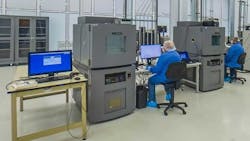This article appeared in Electronic Design and has been published here with permission.
Members can download this article in PDF format.
What you’ll learn:
- Further incorporation of AI/ML technologies into 5G and upcoming 6G systems.
- The need to develop lower-cost products for the FR2 mmWave range.
- 6G’s role in the IIoT and healthcare.
- How Benchmark can help in 6G system development.
In search of effective spectrum use, cellular wireless technology has advanced to today’s fifth-generation (5G) networks. But demands for more bandwidth and faster data transfers compel sixth-generation (6G) networks to be even more creative and efficient in their spectrum consumption than preceding generations.
To serve more users in terms of both people and connected devices, 6G networks will benefit from more mature enabling technologies, many of which were developed for its predecessors.
Currently, there’s no universally accepted definition of what qualifies as 6G technology. Yet, because of the infrastructure’s greater complexity and expanded reach (on the ground and in space as satellites become an integral part of the network), building 6G networks will take time and require greater attention to detail.
Filling the gaps in coverage will require engineering resources and advanced manufacturing methods as well as effective and practical methods to test for signals at higher frequencies and in congested environments. If implemented as planned, 6G networks will coordinate human senses with electronic tools—or “companions”—that bring unprecedented enhancements to our lifestyles.
AI/ML Bring Smarts to Bear
As the global human population grows—along with the demand to communicate with each other (and with our connected devices) via the internet—the need for 6G networks will likewise grow. Thus, engineering solutions will be found at increasingly higher segments of the electromagnetic (EM) frequency spectrum.
Greater use of EM spectrum for communications, positioning, remote control, and warning systems (as well as the many other actions it will be asked to transfer from one point to another) will consume bandwidth quickly, forcing an accelerated journey through 5G technology and a faster-than-anticipated entry into 6G networks. Given the fast pace, there’s no time like the present for the electronics industry to prepare for the coming needs of 6G communications networks.
In preparation for 6G, the globalization of 5G is taking place within three broad bands of frequency spectrum:
- FR1 (˂6 GHz)
- FR2 (24.25 to 71.0 GHz)
- FR3 (7.125 to 24.250 GHz)
Widespread acceptance of 5G wireless technology for mobile communications and wireless devices is rapidly exhausting the bandwidth of the lower frequency range, requiring the higher-frequency, millimeter-wave (mmWave) frequency bands for transmissions that consume wide swathes of bandwidth (such as high-speed data, HSD, signals).
Strong demand for available frequency spectrum is driving the development of 6G equipment and network strategies even before 5G infrastructure has been installed. The 6G systems are projected to include “intelligent” electronic networks based on mmWave transceivers optimized through inclusion of artificial intelligence (AI) and machine learning (ML) technologies.
As 5G gradually evolves into 6G, further adoption of AI and ML technologies in 5G/6G networks will likewise gradually increase reliance on machines for functions or jobs traditionally performed by humans. Larger numbers of electronic devices—not just cellphones but Internet of Things (IoT) sensors converting inputs such as sounds, distances, and speeds into data for immediate access—will boost the energy demands of 6G networks compared to 5G networks.
However, thoughtful application of AI/ML technologies will enable energy conservation within 6G networks. Wireless networks are rapidly evolving to the point where more communications are occurring between people and devices—and even between devices and devices—than between people and people.
AI analysis can determine when power is required during different forms of communications. It can also play a key role in 5G/6G network planning and how to optimize available infrastructure resources, including enhanced network self-healing capabilities.
Getting to Cost-Effective Products for FR2 mmWave Range
As FR1 spectrum is consumed by growing numbers of 5G users, 5G network developers are installing smart infrastructure capable of signal processing within the FR2 range, typically in the form of small cells (compared to larger, more powerful FR1 base stations and antennas). Although the FR2 mmWave frequency range has been in use for some time for military and aerospace applications, designing and developing cost-effective products for this range has posed a challenge for many component houses.
The small dimensions of passive components, e.g., filters, needed to support the shorter signal wavelengths at higher frequencies require both electrical and mechanical precision. Consistent performance demands repeatable manufacturing processes, not to mention being able to measure and tune the performance parameters associated with each component (like return loss and insertion loss across a frequency range of interest).
This growing foray into the design and development of active and passive components in support of 5G small cells hints at the smaller wavelength spectrum that will be occupied at higher 6G frequencies. The advanced wireless-networking capabilities being made possible within the extended frequency ranges of 5G and 6G may be the very technology that enables a large amount of the infrastructure for 6G wireless networks to be installed and maintained over time.
Merging 6G with Industry 4.0
Prognosticators for 6G networks are describing “intelligent” wireless networks with many autonomous functions enabled by intelligent devices, allowing, for instance, remote monitoring and placement of objects in warehouse environments and even on manufacturing floors.
Micrometer placement precision is possible with modern automated pick-and-place machines. However, extending their control beyond a local area network (LAN) to the greater reach of a 6G network will create manufacturing environments in which precision device alignments are possible using autonomous corrections powered by centralized AI/ML technologies.
As a potential example, imagine a printed-circuit-board (PCB) assembly line employing robotic placement of passive device elements, such as resistors and capacitors, and autonomously correcting as needed for variations in circuit laminate thickness beyond the reference tolerance stored in the assembly system’s AI/ML memory. At the same time, the assembly line might be alerting supervisory personnel to any deviations from the manufacturing limits.
With suitable computing power, the related electrical tolerances in each sub-assembled PCB could be stored in a database for that production run with little human interaction, except for notifications and updates via the 5G/6G network.
In the 5G/6G network infrastructure, the use of AI/ML during communications links among electronic devices could help to provide autonomous corrections as needed. Device-to-device data processing with AI could improve the speed of data transmission, reduce the power consumption, and decrease the amount of memory needed for high-speed data processing.
As increased bandwidth becomes available on 6G networks, real-time signal processing will be possible without latency of any significance. This will enable the use of extended-reality (XR) techniques to improve the accuracy and precision of remote monitoring of a production line.
6G’s Benefits in Healthcare
The greater bandwidth available for 6G networks will not only connect greater numbers of users for standard services even within highly populated areas, but it will enable networking functions that aren’t possible due to current 5G FR1 latency issues. When it comes to healthcare, these might include uses such as remote dentistry, ophthalmology, and general medical surgery.
In critical operations, where a medical professional may be controlling robotic equipment remotely located with the patient and medical aides, latency can be potentially life-threatening. Therefore, accurate, high-resolution control of robotic medical equipment requires generous bandwidth for high-speed-digital (HSD) signal processing. The equipment itself will be aided by AI technology using reference models stored within the AI circuit sections of the medical equipment.
As the number of 5G/6G users—human and machine—continues to ramp up, available bandwidth will quickly be consumed. 6G wireless networks are expected to occupy an order of magnitude more frequency spectrum than 5G networks, covering a total frequency range from below 6 GHz to 1 THz. The challenges in working with those “sub-THz” frequencies (1 THz = 1000 GHz), as they’re coming to be known, are much greater than the lower-frequency infrastructure faced by 5G network developers.
The Future is 6G
Not only will 6G offer much more frequency spectrum than 5G, but it also will process a wider variety of signals from the many types of machine and human users compared to current 5G wireless networks. In many ways, 6G networks will behave as neural networks that depend on AI and ML technologies to aid in signal switching and routing with minimum delays and loss of signal power. As 5G grows into 6G, it will become a more timing-dependent communications network in which latency is the bane of many functions.
In addition to providing decision-making algorithms for many dedicated applications, AI will be needed for autonomous networking functions throughout 6G, particularly with sorting and routing signals for the highest-priority needs of the required low-latency communications. To minimize the signal-routing complexity of 6G networks, techniques such as distributed, massive multiple-input, multiple-output (mMIMO) cells are being explored in attempts to upload more signals with fewer cells.
A large part of the 6G network bandwidth will come from space in the form of increased satellite coverage provided by thousands of low-Earth-orbit satellites (LEOs). These satellites will deliver internet access for many hard-to-reach users, such as maritime users operating at frequencies above 100 GHz (Fig. 1).
In addition to human users, large numbers of sensors (or IoT devices) will be interconnected by 6G satellite coverage. LEOs within 6G networks will enable remote machine-to-machine (M2M) interconnections of IoT devices, monitoring devices, robotic equipment, and other electronic equipment, as well as connectivity to data terminals and small-cell terminals.
The sizable percentage of satellite signals in 6G networks compared to earlier network generations poses extremely complex signal routing issues. This is where AI embedded in interconnected devices can help improve the signal-switching decision making.
The Many Challenges of 6G Development
The challenges confronting the builders of 6G infrastructure aren’t unlike those confronting developers of military and aerospace electronic systems, who face even more constraints than today’s forays into FR2. As frequencies increase, the sizes of component features decrease, making it difficult to repeatedly fabricate electronic components and devices for frequencies above 100 GHz.
At the upper range of the mmWave frequency range, a 300-GHz signal has a wavelength of 1 mm. As 6G networks move into the “sub-THz” spectrum, components will be especially small, requiring unparalleled precision in manufacturing.
Not only are components for projected 6G frequencies a rare commodity at present, but they must also be developed with supply-chain limitations in mind. These aren’t components that can easily be replaced even as part of standard maintenance procedures. And as with mil/aero systems, components for 6G networks should be developed with reduced size, weight, power, and cost (SWaP-C) goals, especially for smaller satellites with limited payloads.
Benchmark Can Help Customers Overcome 6G Challenges
Benchmark has worked closely with OEMs on meeting the challenges of higher-frequency subsystem and system design and development well into the mmWave frequency range. It has overcome supply-chain challenges by architecting solutions to meet today’s component challenges.
The company has explored the use of composite materials for applications such as space and satellites, where severe environmental effects must be endured (Fig. 2).
In-house circuit assembly capabilities support design-for-manufacturing (DFM) and design-for-test (DFT) efforts with repeatable and reliable custom assemblies and test fixtures needed for 5G/6G infrastructure equipment (Fig. 3).
Of course, some of the actual DFM and DFT requirements of 6G systems aren’t yet known. However, by working with—and learning from—customers for 5G networks, Benchmark’s engineering teams are learning to apply the latest test equipment to assess key performance parameters. This leads to production of assemblies and subsystems with minimal electromagnetic interference (EMI) and optimum electromagnetic compatibility (EMC) characteristics even as 5G networks evolve into higher-frequency 6G networks approaching terahertz frequencies.
By developing custom test fixtures as needed, effective measurement strategies can be developed for the most highly specialized circuits, modules, and subsystems that will be required in 6G networks, whether testing analog, digital, or mixed-signal designs (Fig. 4). Benchmark’s engineers have collaborated closely with customers to develop practical test strategies that can be applied during production to achieve cost-effective yields needed for the higher-frequency components that will make 6G possible.




